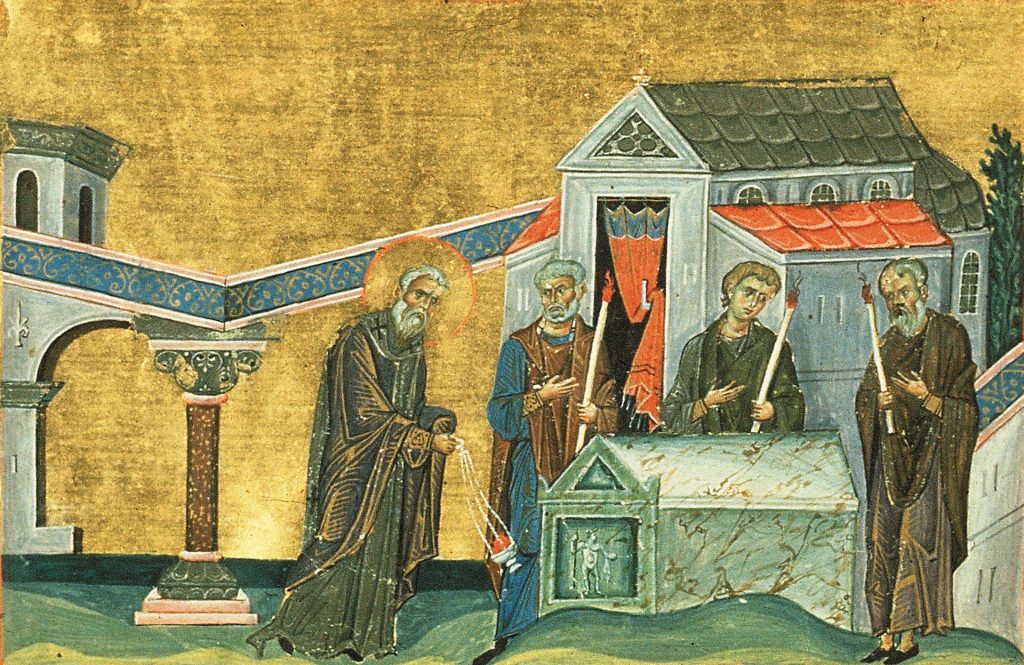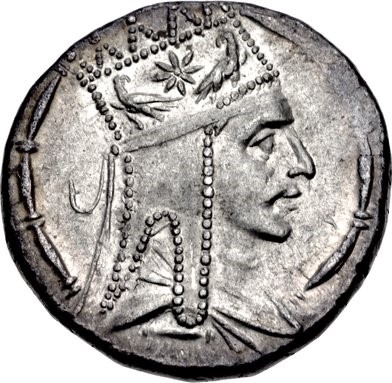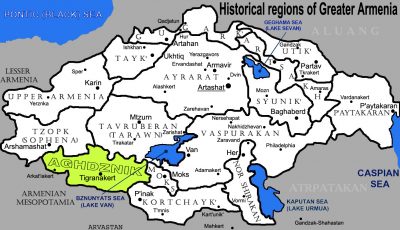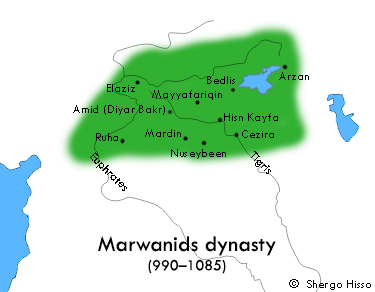Np’rkert (Np’rret) was a district in the Aghdznik province of Greater Armenia. It was spread in the regions on the middle-lower stream of Kaghrid river. To the south, it probably covered some areas south of the Tigris River. Np’rkert was a lowland district, with hot, dry climate, and without forests. The northern part has a mountainous relief. Among the historical places of Np’rkert are the capital city Tigranakert (‘Fortress of Tigran’), Tukh river and Klesur mountain pass.
Administration
From the sixteenth century Np’rkert entered the vilayet of Diyarbekir, forming the Miafarkin sancak. Later it corresponded to the district of Bsherik (Beşiri).
Toponym
It is assumed that the town Silvan was founded under the name Mîpherkat by the Syriac saint Mar Marûthâ (also Maruthas) during the time of Persian ruler Yazdegerd I (399-420); this saint brought into his episcopal city the relics of so many martyrs that it received the Greek surname Martyrópolis (‘Martyr city’), and the saint became known as Mar Marûthâ of Martyropolis. The Armenian name for the area was Np’rkert (Նփրկերտ; also Նփռետ – Np’ret).

The Arabic Mîyafarqîn toponym was used until the early 20th century; still locals prefer the name Farqîn. The Kurdish toponym emerged in the 15th/16th centuries. It derives from the Kurdish principality of Silivanî, founded by the ruler Süleymanlı.
Although Silvan has been identified with the ancient Armenian city of Tigranakert since von Helmuth von Moltke and Carl Friedrich Lehmann-Haupt, this view lacks sufficient evidence.
Currently, the local people use the name Farqin rather than Silvan.[1]
History

The district Np’kert was important during the reign of Tigran II the Great (first century B.C.), when he founded his capital Tigranakert there. The Battle of Martyropolis was fought in summer 588 near Martyropolis between an East Roman (Byzantine) and a Sassanid Persian army, and resulted in a Byzantine victory. In 896, on the banks of the Tukh River, near the fortifications of the Klesur mountain pass, another battle took place between the Armenian forces and the troops of the Emir of Northern Mesopotamia.
Silvan Town: Many names, battles and saints
The administrative seat of the kaza Silvan is located northeast of Diyarbekir, located on the site of the former Martyropolis and perhaps dating back to the Bronze Age Niḫirija.
Silvan / Miyafarkin has been the capital of the Kurdish Mervani (Marvanid) dynasty.
The Marvanids (Kurdish Merwanî, Arabic مروانيون, DMG Marwānīyūn) were a Kurdish dynasty in northern Iraq and southeastern Anatolia that ruled from 990 to 1096. After 983, the Marvanids under Badh, a former shepherd, gained rule over Mayyafariqin and the territories of Amida (Diyarbekir) and Nusaybin.
Another Syriac saint was the monk and martyr Martyrianus of Martyropolis (also: Mari of Beth Sahde -“of the North”), who is commemorated on 10 November by Syriac Orthodox and Catholic Christians. The dates of his life are unknown. According to tradition, Martyrianus died as a martyr in Beth Sahde – a Syriac name of Martyropolis, also known as Tagrith. Martyrianus is first mentioned in 1177 in the records of a monk from Tur Abdin.
Population
According to the 1914 census of the Armenian Patriarchate of Constantinople, there lived 13,824 Armenians in 70 localities of the kaza, maintaining 28 churches, two monasteries, and 35 schools for 1,600 students.[2] The Armenian population was Kurdophone.
The town Miyafarkin had a Christian population of 2,500 Armenian Apostolic Christians and “a combined total of 1,500 Chaldeans, Syriac Catholics, Syriac Orthodox, and Melchites. The Agha Petros population lists gave the size of Miyafarin as 1,250 Assyro-Chaldeans plus an additional 2,750 in 13 surrounding villages. Tfinkdji noted 500 Chaldeans here.”[3]
Today, Silvan town is a Kurdish Sunni settlement.
Destruction 1915
„The location of these villages [in the kazas of Silvan and Beşkiri] may explain why they were attacked very early. (…) the authorities appealed in May to the Kurdish Belek, Bekran, Şegro, and other tribes to attack not only Sasun but also the civilian populations of the kazas of Silvan and Beşiri. While many fell victims to the massacres of the Kurds staged in these villages, several thousand Armenians from the area managed to flee to Sasun, where in August they met the same fate as its own population.
(…) the kaymakam of Silvan, Hakkı Bey, appointed on 4 October 1914, was not transferred elsewhere until 31 August 1915. He participated in the crimes committed there.”
Excerpted from: Kévorkian, Raymond: The Armenian Genocide: A Complete History. London, New York: I.B. Tauris, 2011, p. 307f.
In Miyafarkin town, the “Christians were annihilated, but the circumstances are not known. In December 1915, the Minister of the Interior [Talat] ordered the area repopulated with Muslim refugees from Bayezit and Diyadin.”[4]
Prominent personalities
Aram Ateşyan
Archbishop Aram Ateşyan (baptismal name Artin Ateş; b. 1 January 1954 in Silvan, Diyarbakır Province) is the Deputy Armenian Patriarch of Constantinople and acting head of the Armenian Apostolic Church in Turkey. He temporarily held the office of patriarch until Sahak Mashalian was elected as successor on 12 Dec 2019 and after the then incumbent Mesrop Mutafyan became unfit to serve due to a serious illness.
Aram Ateşyan was baptized Artin Ateş at St. Giragos Cathedral in Diyarbakır and began his educational career in his birthplace of Silvan. He then attended what was at the time Surp Haç Tıbrevank Theology High School in Istanbul. He successfully graduated from Jerusalem Theological Seminary after nine years of study.
Aram Ateşyan’s childhood was not easy. Many of his relatives and family members were forced to convert to Islam with death threats: His brother-in-law, for example, was told that they would kill him if he did not become a Muslim. His sister also converted to Islam in the 1950s. Therefore, his relatives are so-called crypto-Armenians. Aram Ateşyan’s nephew and his nephew’s children were attacked.
In September 2010, Aram Ateşyan presided over the first mass since the Armenian genocide at the renovated Holy Cross Church in Akhtamar, Lake Van.
On April 27, 2013, Ateşyan claimed that up to 90% of the rural population in Tunceli (Dersim) is of Armenian origin. He considers Turkey his motherland (Trk.: Anavatan) and Armenia his fatherland (Arm.: Hayrenik).
Tatevik Lazarian: Turkish-Armenian Bishop Condemned Over Genocide Stance (16.06.2016)
The spiritual leader of Turkey’s small Armenian community has caused outrage in Armenia after criticizing the German parliament for recognizing the 1915 Armenian genocide in the Ottoman Empire.
Archbishop Aram Ateshian, the acting Armenian patriarch of Istanbul, wrote to Turkish President Recep Tayyip Erdogan shortly after the Bundestag overwhelmingly passed a corresponding resolution on 2 June [2016]. In the letter sent on behalf of his community, he said that German lawmakers had “no right” to pass judgment on the Armenian massacres. He also claimed that Armenians are being exploited by “imperialist forces.”
Some prominent members of the community swiftly condemned Ateshian. A Turkish-Armenian newspaper, Agos, ran an angry editorial last week, saying that the letter to Erdogan caused it “sorrow, anger and shame” and is an affront to the memory of the genocide victims.
The archbishop has also faced strong criticism in Armenia, with some local politicians, intellectuals and media figures accusing him of complicity in the Turkish government’s policy of vehement genocide denial.
(…)
The church itself has not joined the chorus of condemnation, however. [Catholicos] Garegin’s press secretary, the Reverend Vahram Melikian, suggested earlier this week that the acting Istanbul patriarch’s letter to Erdogan may have been the result of “coercion.”
Turkey’s Armenian patriarchs have traditionally avoided antagonizing or publicly challenging the Turkish government for fear of putting the safety of their flock at risk.
The Istanbul Patriarchate responded to the outcry on Wednesday with a statement circulated on behalf of its Ecclesiastical Council. It claimed that the content of Ateshian’s letter reflected the “demands of several leading benefactors and heads of community institutions.” It also said that the archbishop “followed the example” of his predecessors.
Excerpted from: http://www.armeniapedia.org/wiki/Aram_Ateshian

